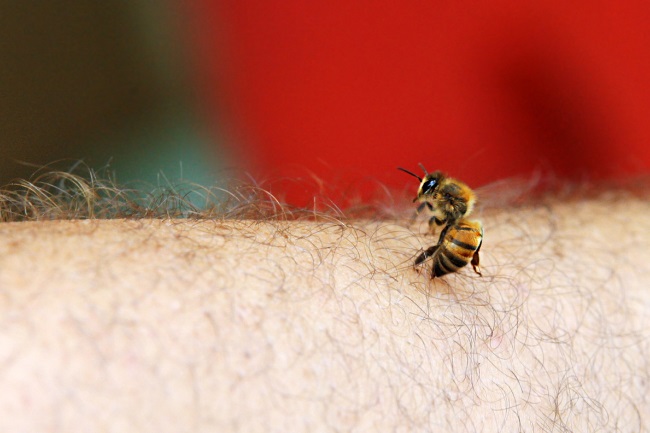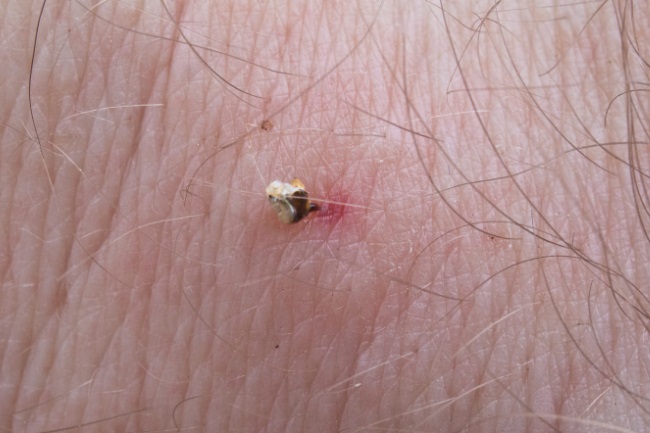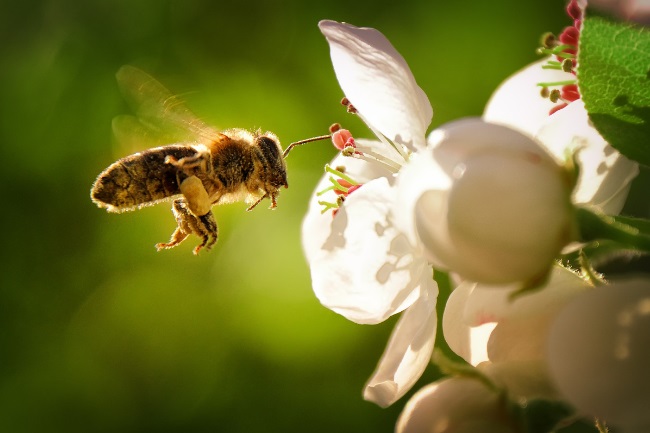Bees are not naturally aggressive. However, they will sting to protect themselves or their hive. Many stings occur by accident when a human steps or leans on a bee, not knowing they are there. Removing a sting is best done quickly and by swiping it off with a flat surface. This limits the amount of venom released into the skin.
Contents
What to do if you’re stung by a bee

Most bees do not lose their stingers when they sting, other than the honey bee. If you’ve been stung by a honey bee, the stinger may remain embedded in your skin. The stinger is comprised of three sections, the needle-like stylet and the hooked lancets on either side. These are hollow, and venom is injected into the skin through them.
Attached to the stinger is a venom sack. This pumps venom down the stinger. When the bee leaves behind its stinger, it also leaves behind the venom sack, constantly pumping more venom down into your skin. So the longer the stinger is in, the more it’s going to hurt. Time is, therefore, of the essence.
| Step | Description |
|---|---|
| Remove the Stinger | Scrape the area with a blunt object to remove the stinger |
| Wash the Area | Clean the affected area with soap and water |
| Apply Ice | Apply a cold compress or ice pack to reduce swelling |
| Take Pain Relievers | Take over-the-counter pain relievers, if necessary |
| Apply Calamine Lotion | Apply calamine lotion or a topical antihistamine to soothe itching and irritation |
| Monitor for Allergic Reactions | Watch for signs of severe allergic reactions, such as difficulty breathing, swelling, or hives. Seek medical help immediately if any of these symptoms occur. |
Swipe, don’t pull

The best thing to remove the stinger with is a flat surface like a credit card. You can then scrap your card along the skin and pull the stinger out sideways. This avoids squashing the venom sack and dumping a load more toxins into your skin. However, if you don’t have something like this to hand, the best thing is just to get the sting out quickly.
It’s also worth knowing that a bee gives out a chemical scent when it stings you, informing other bees to help. Therefore it’s best to lose the stinger as quickly as possible and move away from the area before the cavalry arrives.
Chill out or get help
Once the stinger is out, you can apply ice to the area. This can help to reduce any swelling. However, if you start feeling unwell or know you are allergic to bees, you should seek proper medical attention. More severe signs include nausea and swelling in areas not surrounding the sting, such as on your feet if you were stung on your arm.
Also read: Can a Bumblebee Sting You? Is it Painful?
What to apply after the sting
You can apply any cream marketed to help with insect bites or stings, anti-inflammatory creams or creams to help numb the area. The main aim now is to reduce the swelling and discomfort, as your body does its thing and deals with the venom.
| Home Remedy | Description |
|---|---|
| Baking Soda | Make a paste using baking soda and water, apply to the sting area |
| Honey | Apply a small amount of honey to the sting area |
| Vinegar | Dab vinegar on the sting area to help neutralize the venom |
| Aloe Vera | Apply aloe vera gel to soothe the sting and reduce inflammation |
| Tea Tree Oil | Dilute tea tree oil with a carrier oil and apply to the sting area |
| Onion | Apply a slice of raw onion to the sting for relief |
Also read: Do Cicada Killers Sting? Does it Hurt or is it Dangerous?
How to avoid being stung
The best way to ensure this does not happen is to avoid angering a bee in the first place. Bees largely sting to defend their hive or because they feel threatened. If you come across a hive, simply give it a wide berth, or call in an expert to safely relocate it. You can avoid angering bees by not stepping on them or trying to swat them.
Is it possible to save a bee when it stings?

The vast majority of bees do not sting. This can be for various reasons, either because their stinger is too small to penetrate our skin or because they are too small themselves. Even those that have significant stingers aren’t that interested in causing us pain. They are looking to get on with their day and find food.
Those that do sting can mostly sting multiple times without dying. It is only the honey bee that loses its sting and therefore dies once it has carried out this act. However, this only happens with mammalian skin, and honey bees can sting other insects multiple times without dying. Queen honey bees can also sting more than once if they want to, as they lack the barb on the end of their stinger, which causes it to get stuck in the skin.
| Situation | Description |
|---|---|
| Severe Allergic Reaction | Difficulty breathing, chest tightness, swelling of the face, lips, or tongue, or hives all over the body |
| Multiple Stings | If you’ve been stung multiple times, especially if you are experiencing symptoms beyond localized pain and swelling |
| Previous Allergic Reactions | If you’ve had severe allergic reactions to bee stings in the past |
| Sting Inside the Mouth or Throat | If you’ve been stung inside the mouth or throat, seek immediate medical help |
| Sting by Africanized Bees | Africanized bees, also known as “killer bees,” are more aggressive, and their stings may require medical attention even without an allergic reaction |
Unfortunately, when the sting comes out, it rips out a large section of the honey bee’s abdomen. This means that the bee will die, and there’s no way to revive it.
Also read: When the Queen Bee Dies, What Happens?
Are bees safe to have around?
Many people worry about having bees near them, particularly if they have some children. It’s important to teach your children how to treat wild animals like bees to minimise any danger. However, it’s worth remembering that bees do not want to sting you, and if you respect them, they won’t take much of an interest in you. More importantly, bees provide a vital service by pollinating flowers and many of our crops. So make a little space for bees; their buzz really is worse than their sting.

